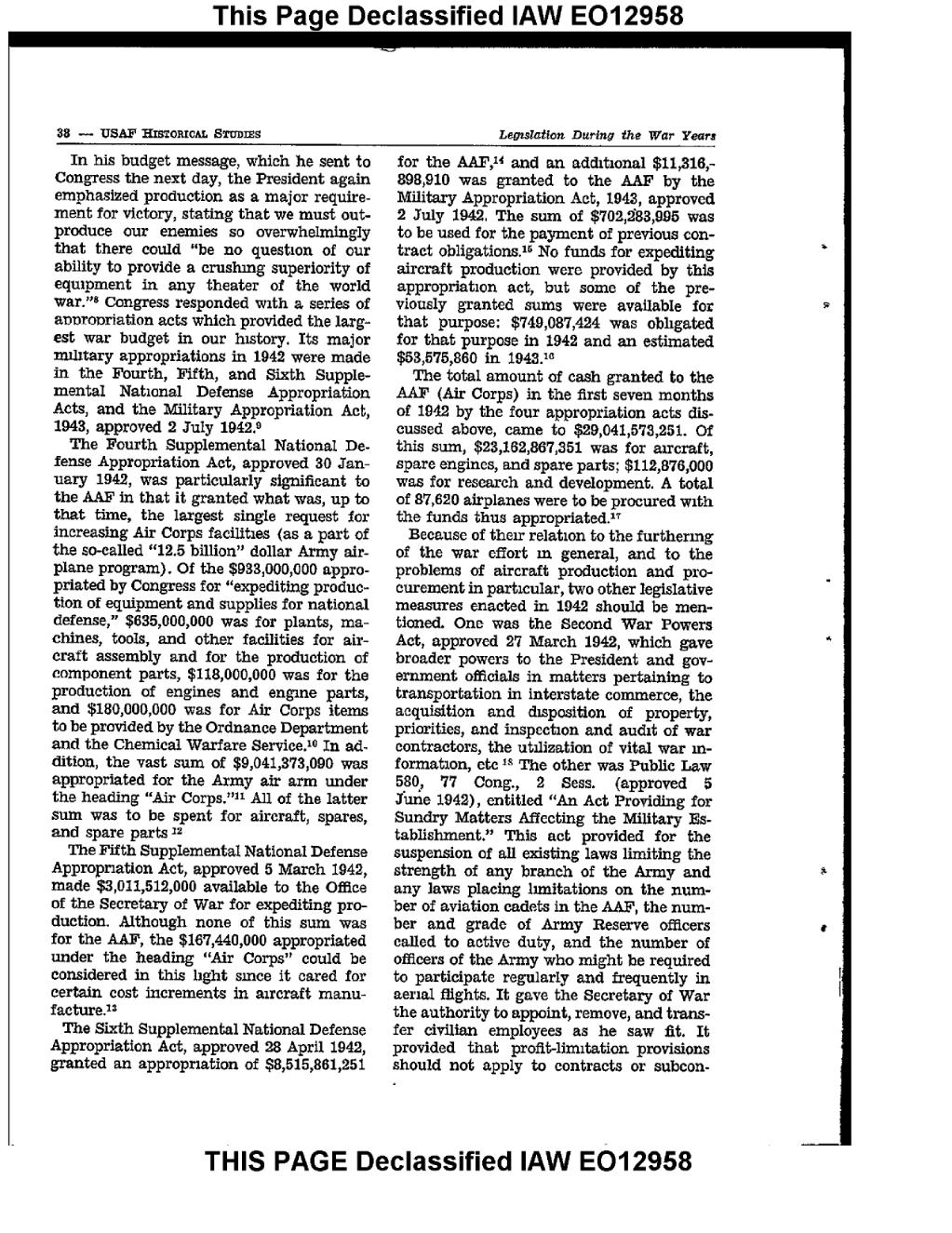�This Page Declassified lAW EO12958 In his budget message, which he sent to Congress the next day, the President again emphasized production as a major require- ment for victory, stating that we must out- produce our enemies so overwheImingly that there could "be no questran of our ability to provide a crushing superiority of equipment in any theater of the world war."? Congress responded w?th a series of a?roDriation acts which provided the larg- est war budget in our h?story. Its major zathtary appropriations in 1942 were made in the Fourth, Fifth, and Sixth Supple- mental Natrenal Defense Appropriation Acts, and the Military Appropriation Act, 1943, approved 2 July 1942. 0 The Fourth Supplemental National De- fense Appropriation Act, approved 30/ran- usry 1942, was particularly significant to the AAF in that it granted what was, up to that time, the largest single request for increasing Air Corps facil/t?es (as a part of the so-called "12.5 billion" dollar Amy air- plane program). Of the $933,000,000 appro- priated by Congress for "expediting produc- tion of equipment and supplies for national defense," $635,000,000 was for plants, ma- chines, tools, and other facilities for air- craft assembly and for the production of component parts, $118,000,000 was for the production of engines and engine parts, and $180,000,000 was for Air Corps items to be provided by the Ordnance Department and the Chemical Warfare ServiceJ? In ad- dition, the vast sum of $9,041,373,090 was appropriated for the Army air arm under the heading "JAr Corps."? JA1 of the latter sum was to be spent for aircraft, spares, and spare parts ? The Fifth Supplemental National Defense Appropriation Act, approved 5 March 1942, made $3,011,512,000 available to the Office of the Secretary of War for expediting pro- duction. Although none of this sum was for the AAF, the $16?,440,000 appropriated under the heading "Air Corps" could be considered in this hght since it cared for certain cost increments in tarcraft manu- facture.? The Shxth Supplemental National Defense Appropriation Act, approved 28 April 1942, granted an appropriation of $8,515,861,251 for the AAF,?< and an adcht?onal $11,?16,- 898,910 was granted to the AAF by the Military Appropriation Act, 1943, approved 2 3ruly 1942. The sum of $702,2?,995 was to be used for the payment of previous con- tract obligations.? No funds for expediting aircraft production were provided by this appropriation act, but some of the pre- viously granted sums were available that purpose: $749,087,424 was obligated for that purpose in 1942 and an estimated $53,575,860 in 1943. TM The totaI amoun? of cash granted to the AAF (Air Corps) in the first seven months of 1942 by the four appropriation acts dis- cussed above, came to $29,041,5?3,251. Of this sum, $23,162,867,351 was for a?rcraft, spare engines, and spare pa?ts; $112,876,000 was for research and development. A total of 87,620 airplanes were ?o be p?ocured with the funds thus appropriated. ? Because of their relation to the furtherrag of the war effort m general, and to the problems of aircraft production and pro- curement in particular, two other legislative measures enacted in 1942 should be men- rioned. One was ?he Second War Powers Act, approved 27 March 1942, which gave broader powers to the President and eminent officials /n ma?ters pertaining to transportation in interstate commerce, the acquisition and titsposition of property, priorities, and inspection and aucht of war contractors, the utilization of vital war m- formation, etc ?s The other was Public Law 5.80., 77 Cong., 2 Sess. (approved 5 June 1942), entitled "An Act Providing for Sundry Matters Affecting the Military tabtishment." This act provided for ?he suspension of all existing laws limiting the strength of any branch of the Army and any laws placing lnnitations on the num- ber of aviation cadets in the AAF, the num- ber and grade of Army Reserve officers called to active duty, and the number of o?cers of the Army who might he required to participate regularly and frequently aenat flights. It gave the Secretary of War the authority to appoint, remove, and trans- fer civilian employees as he saw fit. It provided that profi?-!im[tation provisions should not apply to contracts or subcon. THIS PAGE Declassified lAW EO12958
Page:Legislative History of the AAF and USAF.djvu/45
This page needs to be proofread.
